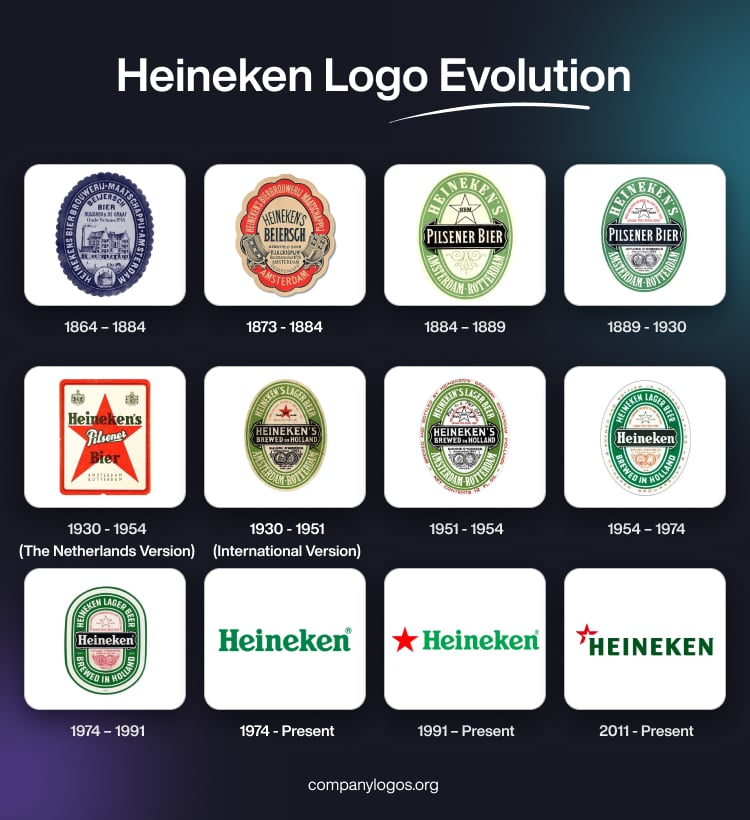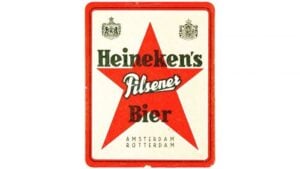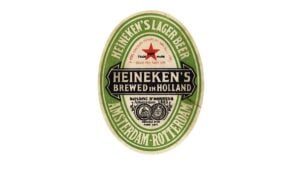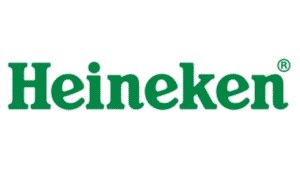
Heineken is arguably one of the most popular and quality-consistent brewing companies in the world. Founded in 1864 in the Netherlands by Gerard Adrian Heineken, the brand now owns over 250 sub-brands and has a massive footprint spanning the world. The Heineken logo is one of the most recognisable symbols in the global beverage industry. It evolved from a detailed, word-heavy label to a minimalist icon. It reflects the brand’s adaptation to changing times and its commitment to tradition. The article explores the evolution of the Heineken logo over the years, among other details about the company.
The Genesis of the Heineken Logo (1864 – 1884)
The first Heineken logo was quite wordy and design rich. It featured a black oval with the text “Heineken’s Bierbrouwerij Maatschappij Amsterdam” in bold white uppercase around the edge with a black background. The centre of the oval in grey had the imagery of the brewery and a few words describing the product.

(1873 – 1884)
The next logo iteration retained most of the features of the previous logo. However, it featured a beige oval with a wide red edge and black outline. The text along the edge remained the same, but the imagery of the brewery at the centre was removed. Also, the word “Heineken’s” in black uppercase appeared at the centre, flanked by coats of arms on the sides.

(1884 – 1889)
By 1984, green colour was chosen to make its bottles stand out from the typical brown beer bottles of the era. The five-pointed star, a wide black horizontal ribbon at the centre with curled edges, and an ornate design at the bottom became dominant features. The first product name, “Pilsner Beer”, in white uppercase, appeared on the black ribbon. Also, the text “Heineken’s Amsterdam-Rotterdam” in white uppercase featured along the green edge to celebrate the birthplace of the beer.

(1889 – 1930)
The logo redesign of 1889 saw the green colour along the edge getting more intense. At the centre of the logo, especially the upper part, were red texts around the five-pointed star with a black outline. The lower part of the logo, especially below the black horizontal ribbon, showed two coins with a few details in monochrome.

(1930 – 1954) (The Netherlands Version)
The 1930 logo saw two versions, one for the Netherlands and another for the global market. The version for the Dutch market featured a large red star within a rectangle with thick red edges and rounded corners. At the top left and right of the rectangular emblem were shown two old coats of arms. The words “HEINEKEN’S, PILSNER, AND BIER” in uppercase appeared across the red star, while “AMSTERDAM-ROTTERDAM” appeared below in smaller size.

(1930 – 1951) (International Version)
The international logo variant featured the oval with the inscriptions “Heineken’s Lager Beer” and “Amsterdam-Rotterdam” in white uppercase set along the green edges. At the centre appeared the wordmark “Heineken’s Brewed in Holland” in two levels on a black horizontal ribbon. Besides, the star in the upper part of the oval appeared in red.

(1951 – 1954)
After the Second World War, the association of the red star with communism prompted a design change. So, in 1951, Heineken switched the star from red to white with a black outline to avoid political connotations. Also, the outer framing of the oval had a long text in red. The rest of the elements in the logo remained the same. This adaptation illustrates the brand’s sensitivity to global contexts and its ability to maintain a universal appeal.

(1954 – 1974)
A key moment came in 1954, when Alfred “Freddy” Heineken, the founder’s grandson and a marketing visionary, redesigned the label for the Dutch market. He introduced several key changes. For instance, the green oval export label became standard in the Netherlands. The black horizontal ribbon at the centre featured only the Heineken name.
The wordmark with gothic-style features was softened as well. Finally, the logo saw the introduction of the distinctive “smiling e”. The letter was given a subtle backward slant to create a friendlier appearance. These refinements established a consistent and approachable brand identity that would serve Heineken well as it expanded globally.

(1974 – 1991)
One of the 1974 logo variants saw the continuation of the previous design, albeit refined with more distinct lines. The green colour along the edges of the flatter oval became more pronounced. Some of the text was removed, while the brand name on the slightly extended black ribbon was enlarged. The inscription at the centre, including the two coins, appeared in red. Also, the outer white framing was circled with a green outline.

(1974 – Present)
The 1974 logo saw the introduction of the brand name in green with a bevelled “e”. The typeface used was a soft sans-serif with mild boldness.

(1991 – Present)
In 1991, Heineken introduced the “Star-Heineken” logo in red. It was a modern design that preserved the brand’s heritage while embracing a contemporary aesthetic. This iteration featured the brand name written in a Heineken Serif typeface. Developed by Eden, it had the signature “smiling e”. Also, to the left of the brand name appeared a bold 5-pointed star in red.

(2011 – Present)
The latest design depicts the logo of the overall company. It retains the characteristics of the 1991 iteration but with subtle differences. The contours of the red star are shown on the upper left corner of the brand name in deep green.

The Elements of the Heineken Logo
Font
The Heineken logo uses the Heineken Serif corporate typeface, which has a bevelled letter “e”.
Colour
The colour palette used in designing the Heineken logo has green, white, and red colours.
The History of Heineken
Heineken is one of the world’s most iconic beer brands, with a legacy that spans over 160 years. It started its journey as a small Amsterdam brewery and has since become a global brewing powerhouse marked by innovation, quality, and international expansion. The Heineken story begins in 1864, when Gerard Adriaan Heineken, who was a 22-year-old entrepreneur from Amsterdam, purchased the De Hooiberg (“The Haystack”) brewery. Driven by a vision to produce superior-quality beer, Gerard focused on adopting the latest brewing techniques and prioritising quality. In 1869, Heineken switched to bottom-fermenting yeast, which allowed for a cleaner and more consistent lager.
In 1873, the brewery was renamed Heineken’s Bierbrouwerij Maatschappij (HBM), and a second brewery was opened in Rotterdam a year later. The same year, Gerard established a dedicated quality control lab, which was the first of its kind in the brewing industry. This commitment to science and innovation set Heineken apart from its competitors.
Heineken’s pursuit of excellence quickly paid off. The brewery won several prestigious awards in its early years. These included the Medaille d’Or at the International Maritime Exhibition in Paris in 1875, the Diplome d’Honneur at the International Colonial and Export Exhibition in Amsterdam in 1883, and the Grand Prix at the Paris Expo in 1889. These accolades helped Heineken become the largest beer exporter to France and established its reputation for quality.
A major breakthrough came in 1886 when Dr H. Elion, a student of Louis Pasteur, developed the “Heineken A-yeast” in the company’s laboratory. This unique yeast strain remains a key ingredient in Heineken beer to this day.
Under the leadership of Gerard’s son, Henry Pierre Heineken, the company continued to innovate and expand. Henry Pierre managed the brewery from 1917 to 1940 and focused on maintaining consistent quality at scale. After the First World War, Heineken intensified its export efforts. Also, just three days after Prohibition ended in the United States in 1933, Heineken shipped its first beer to New York. It thus became one of America’s most popular imported beers.
Throughout the 20th century, Heineken continued to grow by acquiring breweries. It expanded its product range and established a strong global presence. The introduction of the iconic green bottle in 1933 further distinguished the brand in international markets.
Heineken’s commitment to innovation has remained steadfast. In 1975, the company launched Heineken 0.0, its first non-alcoholic beer. The company also made strategic acquisitions, such as the purchase of Scottish & Newcastle in 2008. It expanded into new markets, including opening a state-of-the-art brewery in Meoqui, Mexico, in 2018. Heineken has also become a prominent sponsor of major global events, such as the UEFA Champions League. These sponsorships cemented its status further as a premium international brand.
Today, Heineken is recognised as one of the world’s leading brewers. It is known for its distinctive green bottles, red star logo, and ongoing dedication to quality. The company continues to innovate while honouring its rich heritage and produces beers and ciders that are enjoyed by millions worldwide.
Interesting Facts About Heineken
- Heineken was founded in 1864, in Amsterdam, Netherlands, by Gerard Adriaan Heineken. It remains a proudly Dutch brand, even though its subsidiaries and products are now spread all over the world.
- Before becoming Heineken, the brewery was known as “De Hooiberg” (The Haystack), which Gerard Heineken purchased at just 22 years old. He changed the name to Heineken in 1873.
- In 1933, Heineken introduced its now-iconic green bottle, which set it apart from the typical brown bottles used by most other brewers at the time.
- Heineken was the first imported beer to arrive in the United States after Prohibition ended in 1933. Within four years, its exports to the U.S. had increased by 600%.
- The unique A-yeast strain, developed in 1886 by Dr H. Elion (a student of Louis Pasteur), is still used today. This proprietary yeast is a closely guarded secret and is key to the signature flavour of Heineken.
- The three lowercase “e” in the Heineken logo are intentionally slanted to resemble a smile. This was introduced by Alfred Heineken, the founder’s grandson, to give the brand a friendly, approachable feel.
- The red star on the Heineken label has mediaeval origins. It symbolised the magic and elements of brewing. During the Cold War, Heineken changed the star to white with a red border to avoid communist associations. However, it reverted to a full red star in 1991.
- Heineken beer is now available in nearly 200 countries. The company owns or controls over 300 beer and cider brands worldwide. These include Amstel, Sol, Tiger, Birra Moretti, Red Stripe, and Kingfisher.
- In 2012, Heineken acquired Desperados, which is a tequila-flavoured beer targeting younger consumers given to enjoying the nightlife. It’s available in several flavours and is classified as a malt beverage.
- Heineken was the first brewer to introduce a quality control lab and continues to invest in sustainable brewing. This is apparent in the opening of its state-of-the-art brewery in Meoqui, Mexico, in 2018.
- Heineken won the prestigious Medaille d’Or at the International Maritime Exhibition in Paris in 1875 and the Grand Prix at the Paris Expo in 1889. These awards are still proudly displayed on Heineken labels today.
- Heineken has been featured in James Bond movies since 1997. This turned out to be one of the most popular marketing associations.
- As early as 1975, Heineken launched its first non-alcoholic beer, Heineken 0.0. It catered to a growing demand for healthier alternatives.
- Heineken is the official beer sponsor of the UEFA Champions League. This has further enhanced its reputation as a premium international brand.
Finally
Heineken’s logo is not just a mark of quality beer; it is a case study in the power of consistent, adaptable branding. The evolution of its logo reflects broader trends in design and marketing. Its universal recognition is a testament to the brand’s global reach and cultural significance. The Heineken logo, with its distinctive green, red, and white palette and “smiling e”, stands as a symbol of both tradition and innovation. It remains an enduring emblem in the world of beer.